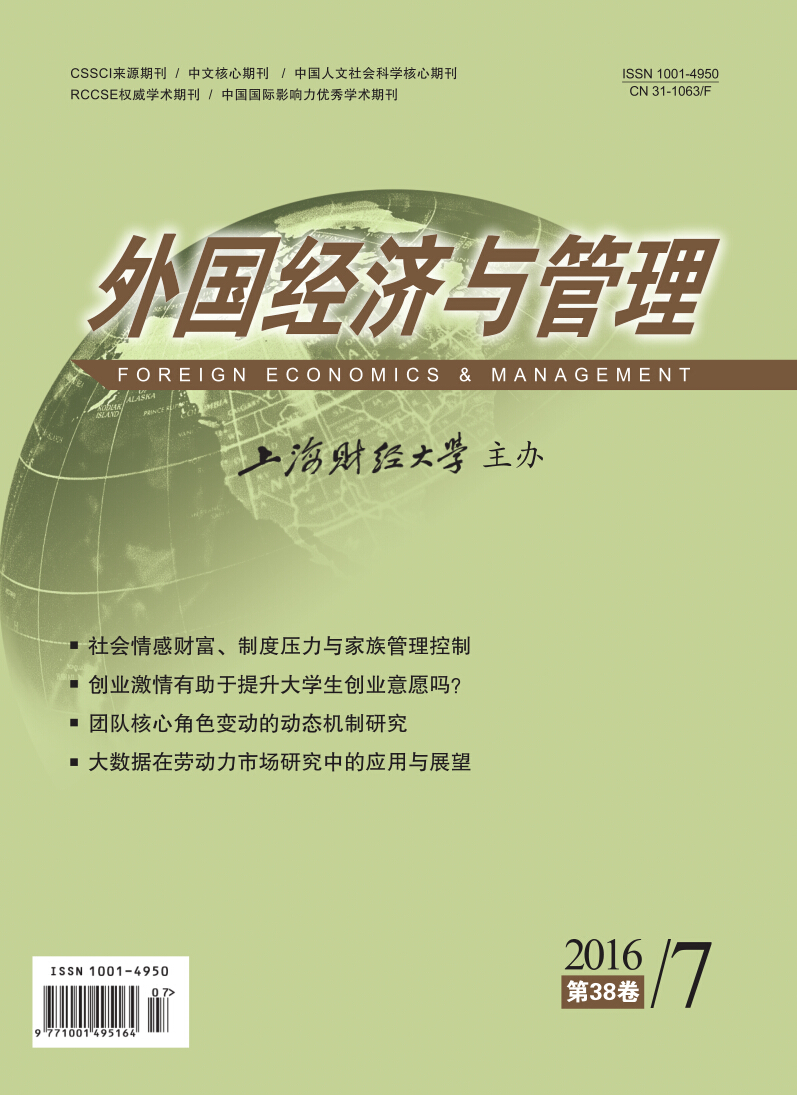本研究从动态视角,运用间断平衡理论解释团队核心成员的变动对团队绩效的动态影响机制,并且基于30个NBA团队11个常规赛季的数据样本对理论模型进行检验。研究结果表明,离职成员的岗位技能与团队绩效损失正相关,而替代成员的岗位技能及团队经验均对团队绩效损失起到抑制作用,且这些影响可以通过团队协同的不稳定性流出这一过程间接作用于团队绩效。最后,本研究总结了研究结果对团队成员变动研究的理论贡献和对企业管理的实践意义。
团队核心角色变动的动态机制研究——基于间断平衡理论的分析
摘要
参考文献
摘要
关键词
1 孟晓斌, 王重鸣, 杨建锋. 企业组织变革中的动态能力多层适应性探析[J]. 外国经济与管理, 2008, (2):1-8, 15.
2 朱其权, 龙立荣. 国外员工变革反应研究综述[J]. 外国经济与管理, 2011, (8):41-49.
3 Abramis D J. Work role ambiguity, job satisfaction, and job performance:Meta-analyses and review[J]. Psychological Reports, 1994, 75(12):811-833.
4 Anderson P, Tushman M L. Technological discontinuities and dominant designs:A cyclical model of technological change[J]. Administrative Science Quarterly, 1990, 35(4):604-633.
5 Arrow H, McGrath J E, Berdahl J L. Small groups as complex systems[M]. Thousand Oaks:Sage, 2000.
6 Arrow H, McGrath J E. Membership dynamics in groups at work:A theoretical framework[A]. Cummings L L, Staw B M. Research in Organizational Behavior[M]. Greenwich, CT:JAI Press, 1995, 17:373-411.
7 Baer M, Leenders R T A J, Oldham G R, et al. Win or lose the battle for creativity:The power and perils of intergroup competition[J]. Academy of Management Journal, 2010, 53(4):827-845.
8 Bunderson J S, van der Vegt G S, Sparrowe R T. Status inertia and member replacement in role-differentiated teams[J]. Organization Science, 2012.8, 25(1):57-72.
9 Clemente F M, Martins F M L, Kalamaras D, et al. Network analysis in basketball:Inspecting the prominent players using centrality metrics[J]. Journal of Physical Education and Sport, 2015, 15(2):212-217.
10 García-Izquierdo A L, Ramos-Villagrasa P J, Navarro J. Dynamic criteria:A longitudinal analysis of professional basketball players' outcomes[J]. The Spanish Journal of Psychology, 2012, 15(3):1133-1146.
11 Gersick C J G. Revolutionary change theories:A multilevel exploration of the punctuated equilibrium paradigm[J]. Academy of Management Review, 1991, 16(1):10-36.
12 Harris C M, McMahan G C. The influence of compensation on leader human capital and unit performance[J]. SAM Advanced Management Journal, 2015, 80(1):33-40.
13 Helms W S, Oliver C. Radical settlements to conflict:Conflict management and its implications for institutional change[J]. Journal of Management & Organization, 2015, 21(4):471-494.
14 Humphrey S E, Morgeson F P, Mannor M J. Developing a theory of the strategic strategic core of teams:A role composition model of team performance[J]. Journal of Applied Psychology, 2009, 94(1):48-61.
15 Kim P H. When what you know can hurt you:A study of experiential effects on group discussion and performance[J]. Organizational Behavior and Human Decision Processes, 1997, 69(2):165-177.
16 Lewis K. Measuring transactive memory systems in the field:Scale development and validation[J]. Journal of Applied Psychology, 2003, 88(4):587-604.
17 Malone T W, Crowston K. The interdisciplinary study of coordination[J]. ACM Computing Surveys (CSUR), 1994, 26(1):87-119.
18 Marks M A, Mathieu J E, Zaccaro S J. A temporally based framework and taxonomy of team processes[J]. Academy of Management Review, 2001, 26(3):356-376.
19 Morgeson F P, Delaney-Klinger K, Hemingway M A. The importance of job autonomy, cognitive ability, and job-related skill for predicting role breadth and job performance[J]. Journal of Applied Psychology, 2005, 90(2):399-406.
20 Pearsall M J, Ellis A P J. The effects of critical team member assertiveness on team performance and satisfaction[J]. Journal of Management, 2006, 32(4):575-594.
21 Piazza A, Castellucci F. Status in organization and management theory[J]. Journal of Management, 2012.8, 40(1):287-315.
22 Ridgeway C L, Berger J. Expectations, legitimation, and dominance behavior in task groups[J]. American Sociological Review, 1986, 51(5):603-617.
23 Rink F, Kane A A, Ellemers N, et al. Team receptivity to newcomers:Five decades of evidence and future research themes[J]. The Academy of Management Annals, 2012.8, 7(1):247-293.
24 Staw B M, Hoang H. Sunk costs in the NBA:Why draft order affects playing time and survival in professional basketball[J]. Administrative Science Quarterly, 1995, 40(3):474-494.
25 Tuckman B W. Developmental sequence in small groups[J]. Psychological Bulletin, 1965, 63(6):384-399.
26 Turner J R. Hierarchical linear modeling testing multilevel theories[J]. Advances in Developing Human Resources, 2015, 17(1):88-101.
27 van der Voet J, Groeneveld S, Kuipers B S. Talking the talk or walking the walk The leadership of planned and emergent change in a public organization[J]. Journal of Change Management, 2012, 8(2):171-191.
28 Wollin A. Punctuated equilibrium:Reconciling theory of revolutionary and incremental change[J]. Systems Research and Behavioral Science, 1999, 16(4):359-367.
29 Wooden J, Nater S. John Wooden's UCLA offense[M]. Champaign:Human Kinetics, 2006.
引用本文
张悦, 梁巧转. 团队核心角色变动的动态机制研究——基于间断平衡理论的分析[J]. 外国经济与管理, 2016, 38(7): 76–85.
导出参考文献,格式为:
上一篇:组织话语研究述评及展望
下一篇:组织中的明星研究回顾与展望





 7343
7343  9404
9404

